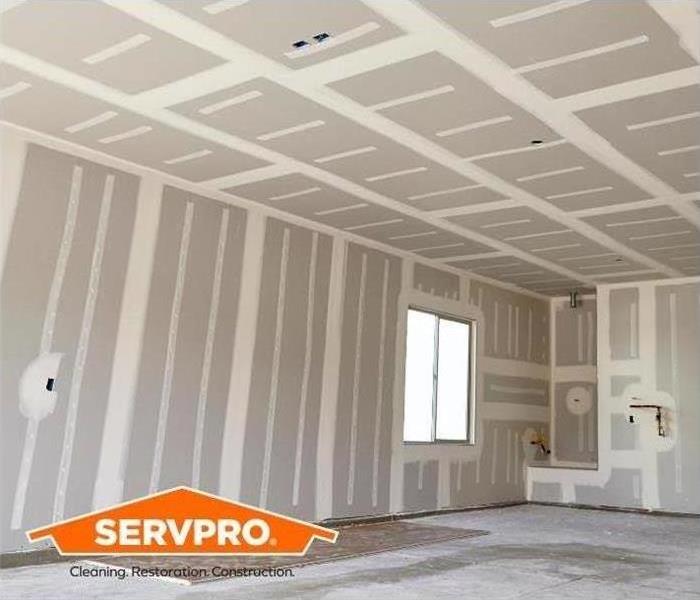Why does drywall need to be removed and not dried after a water loss?
11/11/2024 (Permalink)
 Just because the water damage has been remediated, it doesn't mean the drywall is ready to use.
Just because the water damage has been remediated, it doesn't mean the drywall is ready to use.
When a restoration company places drying equipment, drywall can be dried within 3 to 5 days. However, in some cases, the drywall will require removal due to certain circumstances during water damage.
- If drywall is affected by "grey or black water" that carries contaminates- The drywall will have to be removed and replaced. Examples of this type of water can be found here.
- If drywall has wet insulation in the wall cavities, the drywall and insulation will have to be removed and replaced.
- If drywall has double layers, the drywall's layers must be removed and replaced.
- If drywall was not professionally dried and secondary damages occurred- The drywall will have to be removed and replaced.
Suffering from a water loss is never easy, but we are here to help minimize the impact on your family. Give your team at Downtown New Orleans/Team MLR a call 24/7 to see how we can mitigate any water damage your home or business may experience!
Inundation and its aftermath: The immediate impact that leaves no corner untouched.
11/1/2023 (Permalink)
 SERVPRO Van with logo.
SERVPRO Van with logo.
When a storm unleashes its full fury, the result is a powerful inundation that spares no corner of your New Orleans area home. The rapid influx of water infiltrates every nook and cranny, leaving behind a trail of destruction. Water enters every crevice from the ground floor to the upper levels, leaving no area untouched.
As the water invades your living spaces, furniture, carpets, and belongings are soaked, bearing witness to the storm's force. Floors become slippery, making movement treacherous. Electrical systems are compromised, raising safety concerns. The immediate aftermath can leave you overwhelmed and confused.
Visible damage is only part of the story. Water seeps into hidden recesses and beneath floorboards, causing additional harm. Structural elements may weaken over time. Immediate action is crucial to prevent further deterioration and minimize long-term consequences. SERVPRO of New Orleans/MLR recognizes the urgency of addressing the immediate impact of inundation. Our experienced team arrives swiftly, equipped with the tools and expertise to extract standing water and begin drying.
Call the experts at SERVPRO today and let us handle all of your water and storm remediation needs for your home or office.
Here are 8 reasons why your toilet might be leaking.
8/9/2023 (Permalink)
 Leaking toilet.
Leaking toilet.
We have all walked past the bathroom and hear the water running in the back of the toilet and either jiggled the handle or lifted the back to see if anything was obviously wrong. Water leaking around your toilet can soak into the floor and beyond. It is important to take action if you see a puddle of water around the toilet bowl or even hear a slow drip somewhere behind the wall.
1. Tank is Cracked
While tanks and bowls are pretty durable, they can get cracks. These often start with a small, hairline crack, but can get bigger. Toilets may get shifted or jarred and can get cracked in the back where you won’t notice them.
2. Worn Washers
There are two large bolts that keep the tank attached to the bowl, and two more that keep the toilet bolted to the floor. If the bolts or washers get stripped, rusted out, break, or wear out, they won’t be able to hold it all together.
3. Pipe Corrosion
There could be corrosion in your pipes because of age, impurities in the water, or heavy metals in your water. Rust will develop in the metallic portions of the toilet because of this corrosion.
Pipe corrosion can often cause a lot of damage because you often don’t know it is even there.
4. Float
The float is the hollow ball that floats on the surface of the water in your toilet tank. It can become unhooked, cracked, or it isn’t lined up properly, and the fill valve may run too much, causing a leak. The chain may come off, or if it gets a crack, it can take on water and not work properly.
5. Faulty Supply Line
If there is any kind of damage to supply lines, it can put a major strain on your toilet. Sometimes, if the joints in a supply line come undone and break down, water starts to drip out. The rubber lining in a supply line can also start to leak after several years.
6. Worn-Out Fill Valve
The fill valve on the toilet can also wear down over time. This is often due to mineral deposits, but they can also rust. If enough builds up to warp the fill valve, it can stop working properly, preventing your toilet from shutting off and causing leakage.
7. Stuck or Worn-out Flapper
The flapper is that plug in the bottom of your tank. It releases the water when you flush. If it gets stuck, either open or closed, you have a problem. This can also happen if your handle is stuck.
If the flapper is stuck open, the fill valve will not shut off, so it will just keep running. If the flapper wears out, no longer fits properly, or gets a tear, then it will not be able to regulate the water in the tank.
8. Broken Connections
Your toilet has many different connectors that prevent water leaks. If any of these connections lose their seal, water may end up on your bathroom floor. You can check your toilet’s connections to see if there are any problems before they turn into leaks.
If you find you are dealing with a water loss from any of the above issues, call a plumber to address the leak. Once the leak is fixed SERVPRO of West El Paso is here to help! We can make sure the area is dry and help prevent further issues like microbial growth!

 24/7 Emergency Service
24/7 Emergency Service


